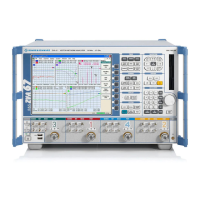System Overview
R&S
®
ZVA
81Getting Started 1145.1090.62 ─ 13
You can also read the converted admittances in a reflection coefficient measurement
from the inverted Smith chart.
3.3.2.6 Y-Parameters
The Y-parameters describe the admittances of a DUT with output ports terminated in a
short circuit (V = 0). The analyzer provides the full set of Y-parameters including the
transfer admittances (i.e. the complete n x n Y-matrix for an n port DUT).
This means that Y-parameters can be used as an alternative to S-parameters (or Z-
parameters) in order to completely characterize a linear n-port network.
3.3.2.7 2-Port Y-Parameters
In analogy to S-parameters, Y-parameters are expressed as Y
<out>< in>
, where <out>
and <in> denote the output and input port numbers of the DUT. In analogy to Z-param-
eters, the Y-parameters for a two-port are based on a circuit model that can be
expressed with two linear equations:
2221212
2121111
VYVYI
VYVYI
Meaning of Y-parameters
The four 2-port Y-parameters can be interpreted as follows:
●
Y
11
is the input admittance, defined as the ratio of the current I
1
to the voltage V
1
,
measured at port 1 (forward measurement with output terminated in a short circuit,
V
2
= 0).
●
Y
21
is the forward transfer admittance, defined as the ratio of the current I
2
to the
voltage V
1
(forward measurement with output terminated in a short circuit, V
2
= 0).
●
Y
12
is the reverse transfer admittance, defined as the ratio of the current I
1
to the
voltage V
2
(reverse measurement with input terminated in a short circuit, V
1
= 0).
●
Y
22
is the output admittance, defined as the ratio of the current I
2
to the voltage V
2
,
measured at port 2 (reverse measurement with input terminated in a short circuit,
V
1
= 0).
Y-parameters can be easily extended to describe circuits with more than two ports or
several modes of propagation.
3.3.2.8 Wave Quantities and Ratios
The elements of the S-, Z- and Y-matrices represent fixed ratios of complex wave
amplitudes. As long as the assumption of linearity holds, the S-, Z- and Y-parameters
are independent of the source power.
Measured Quantities

